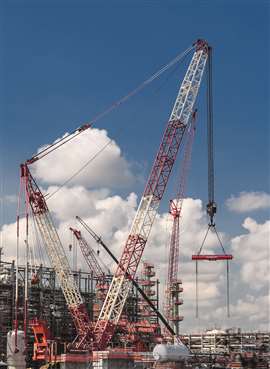How can crane rental companies leverage benchmarking?
12 June 2023
Crane owners face a challenging environment in the years ahead. While direct government spending, as well as subsidies, will result in hundreds of billions of dollars of project spending over the next decade, most crane owners must invest in refreshing their fleets to capitalize on these projects.
Fleet refreshment doesn’t come cheap: the higher cost of new cranes, combined with today’s increased cost of capital and a declining used crane market, will make new fleet investments challenging to fund.
 Benchmarking can help crane owners understand their positioning relative to their competitors based on facts and data, rather than anecdotal information. Photo: Robert Dimmitt Photography
Benchmarking can help crane owners understand their positioning relative to their competitors based on facts and data, rather than anecdotal information. Photo: Robert Dimmitt Photography
“The price of new cranes is up into the mid-teen percentages in just the last couple years, and significantly more than that over the last five to ten years,” said Kregg Lunsford, president of TNT Crane.
Higher labor costs and a historically flat rental rate environment will also add layers of complexity that crane owners will have to negotiate to drive returns.
The good news is crane owners can leverage benchmarking to make better-informed decisions as they navigate these challenges.
“The crane sector has an opportunity to take a step forward relative to other industries and start leveraging benchmarking, data and analytics to improve decision-making,” said Paul McDonnell, CEO of Maxim Crane.
Directed spending
Under the Biden Administration, Congress passed spending bills that will result in direct spending on infrastructure and potentially trillions of dollars in subsidized renewable and manufacturing investment. The Inflation Reduction Act created tax credits and subsidies for investments in renewable power generation, energy storage and transmission infrastructure that could lead to trillions of dollars in project spending over the next decade. The $52 billion CHIPS and Science Act will lead to hundreds of billions of dollars in investment in domestic semiconductor fabrication plant capacity. Finally, the $1.2 trillion infrastructure bill allocates a similar amount in spending to transportation, wastewater treatment, energy and other infrastructure projects.
All these infrastructure, renewable energy and manufacturing projects will create tailwinds for demand over the next decade. Crane companies with newer fleets and strong track records of safe operation on bigger projects will be well positioned to win an outsized share of the business. However, supply constraints and an uncertain economic outlook have prevented crane owners from making investments in new fleet over the past few years. As a result, crane fleets have aged significantly. And even as crane owners invest in refreshing their fleets, they face higher new crane pricing due to increased raw material and labor costs that OEMs are passing along to buyers.
Higher pricing is compounded by a higher cost of capital that will make new crane purchases more difficult to finance. Meanwhile, rental rates have ticked up just 4 to 5 percent following the pandemic as rental demand has increased, while used equipment pricing has declined from recent highs and remains flat to slightly down relative to pre-pandemic levels.
To effectively manage their fleets and drive returns on their investments, crane owners will have to leverage data, benchmarking and analytics the way other industries have for years. Industries like hospitality, transportation, real estate and many others have been benchmarking themselves against their peers for decades.
Valuable data
General rental companies and heavy equipment dealers have been leveraging Rouse Services to benchmark their fleet values, rental rates, utilization, ROI and supply and demand metrics against their peers for nearly 15 years.
“I worked closely with the team at Rouse to develop benchmarking for the general and specialty rental industry during my time at United Rentals,” said McDonnell. “Rouse had a transformative impact on the industry and enabled rental companies to more effectively measure the performance of their people and their assets.”
Participating companies submit their asset, rental and equipment sale invoice data to Rouse’s benchmarking pool. Rouse cleanses, standardizes, aggregates and de-identifies this information to
help participants answer questions like, “What is my 2013 Liebherr LTM 100 worth?” and “How does my hourly rate on a 150-ton all-terrain crane in Houston compare to the rates achieved by my peers?”
More than 350 companies representing $75 billion in fleet OEC, $31 billion in rental revenue and $24 billion in equipment sale transaction volume participate in the Rouse Services benchmarking pool.
Rouse has recently expanded its offering into the crane space with the support of industry leaders Maxim, Bigge, TNT Crane, Sterling, Mountain Crane Service and more than a dozen other leading crane companies and dealers. Companies that submit their data into the benchmarking pool receive access to an initial assessment of their performance relative to their peer group at no cost. They also get access to Rouse’s cutting-edge fleet performance management tools.
“Rouse provides management teams with an unbiased source of information regarding what is happening in the market, so we aren’t solely dependent on anecdotal information,” said Mark Irion, CEO of TNT Crane. “They also have a sophisticated analytics tool that helps to measure our own rate data, which can be quite complicated given the various types of customers and billing options.
“Having access to better data gives fleet owners the ability to make better informed decisions to drive profitable growth,” Irion said.
Peer benchmarking
As crane owners face the challenges of a rising cost environment – new cranes, financing, labor, fuel –peer benchmarking is the critical tool that will enable them to measure the performance of their assets and their teams. Benchmarking will help owners understand their positioning relative to their competitors based on facts and data, rather than anecdotal information filtered through their sales force.
Benchmarking will also help crane owners better understand market supply and demand so they can make well-informed fleet management and capital allocation decisions. Lastly, it will enable them to effectively measure the performance of their sales and operational leaders, so they can establish achievable targets, track progress and continually drive improvement.
THE AUTHOR

Phil Mause is vice president of Rouse Services, a leading provider of insights on used equipment and rental markets in the construction industry. Mause joined Rouse Services in 2010 to build Rouse Analytics, which provides rate and utilization benchmarking to over 350 rental companies and dealers across North America, the United Kingdom and Australia. Rouse collects nightly data on over $75 billion of fleet and $31 billion in annual rental transaction volume.
STAY CONNECTED


Receive the information you need when you need it through our world-leading magazines, newsletters and daily briefings.



